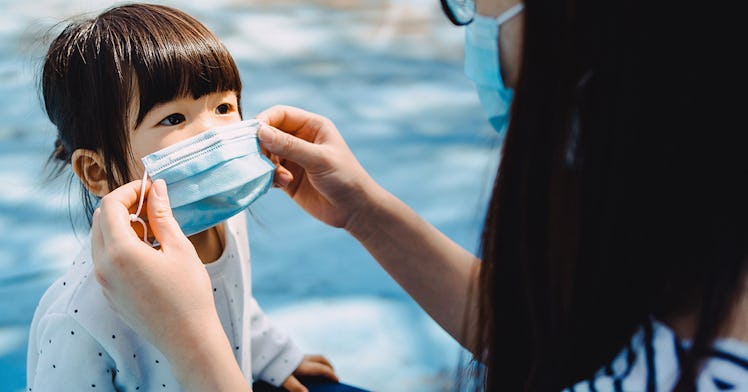Does Your Kid Have to Wear a Mask Outside?
The CDC is asking all adults to wear masks anytime they step out right now. But what about kids? Here are the guidelines.

Health officials have given us whiplash over the past several weeks with their guidance on masks. First, the Centers for Disease Control and Prevention (CDC) said only sick people should wear one. Now, they recommend that almost everyone over the age of two sport a cloth mask in public to limit transmission of COVID-19. Some areas, including Los Angeles and Miami, are even ordering residents to wear masks in public. But keeping a mask on your kid’s face is tricky, to say the least. Is the fight actually worth it?
“If you can get a child to keep a mask on their face when they are outside, not indoors, you should,” says Dyan Hes, the medical director of Gramercy Pediatrics in New York City and a pediatrics professor at Weill Medical College of Cornell University. Hes realizes that’s easier said than done. “They rip them off in like three seconds,” she says, but it’s important to try anyway.
In a set of guidelines released yesterday, the American Academy of Pediatrics offers a few caveats to the all-mask-all-the-time rule. They include skipping masks when kids are at home, taking special precautions with kids who have severe cognitive or respiratory impairments (including monitoring them with a pulse oximeter) and also, a bit confusingly, not worrying so much if people aren’t around and kids can keep their hands off oft-touched surfaces:
If children can be kept at least 6 feet away from others, and not be in contact with surfaces that could harbor the virus, then they do not need a mask for the protection of themselves or others.
For example, during a walk outdoors, as long as children can maintain social distancing of more than 6 feet and do not touch tables, water fountains, playground equipment or other things that infected people might have touched, then they will not acquire the infection and would not need masks.
If this sounds like an impossible ask for your kid (not touching surfaces is a high-bar indeed for elementary-aged and under), you probably should start training your kid on a mask when they’re outside.
The purpose of wearing a mask isn’t to keep your kid safe so much as to prevent your little germ incubator from spreading disease. As many as 25 percent of cases of COVID-19 are asymptomatic, the director of the CDC told NPR. Many of those who are infected without symptoms are probably kids. “All children should be wearing masks because they’re probably the ones who are shedding the virus.” Covering your child’s face helps prevent them from spraying droplets with coronavirus into the air, whether they seem sick or not.
Masks should have a snug fit against the side of the face. Medical-grade masks designed for kids’ small faces are difficult to find, and adult models probably won’t fit your kid. But you shouldn’t be using them anyway. The CDC recommends saving medical and surgical masks that are in short supply for healthcare workers. The general public should use cloth masks, which you can make out of materials like bandanas or T-shirts. Atrium Health provides a guide for sewing cloth masks to fit both adults and young children. But anything is better than nothing, Hes says. “You should have some kind of mask on, whether it’s a scarf, a bandana, or some other kind of protection.” She’s even heard of people wearing ski masks or eye masks over their mouth and nose.
Infants, however, get a pass with the mask, according to the CDC. Obstructing the airway of kids age 2 and younger is dangerous, Hes says. But age 2 is not a hard cutoff. If you think a mask is risky for your child, trust your gut. “You have to use judgment as a parent,” Hes says. If you must bring your infant into public, limit exposure by pushing them in a stroller with a sunshield or rain cover. In addition, children who are having trouble breathing or may be unable to remove their own mask should not wear one.
Wearing a mask alone, especially a cloth one, isn’t enough to stop the spread of COVID-19. Cloth masks don’t have the same antiviral properties as the medical kind. “They help a bit, but they’re not foolproof,” Hes says, so social distancing is just as important as ever. To make your child’s mask as effective as possible, have your kid wash their hands before they put their mask on and after they take it off, according to the World Health Organization. Clean the mask in the washing machine as soon as it gets damp, and remove it from the face by using the straps around the ears. And if your child touches their mask while wearing it, have them wash their hands or use hand sanitizer. If that sounds like a lot of hand-washing, that’s because it is. Don’t skimp, and stay safe.
This article was originally published on